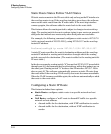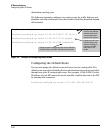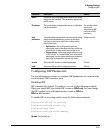
IP Routing Features
Configuring Static IP Routes
Static Route States Follow VLAN States
IP static routes remain in the IP route table only so long as the IP interface to
the next-hop router is up. If the next-hop interface goes down, the software
removes the static route from the IP route table. If the next-hop interface
comes up again, the software adds the route back to the route table.
This feature allows the routing switch to adjust to changes in network top-
ology. The routing switch does not continue trying to use routes on unreach-
able paths but instead uses routes only when their paths are reachable.
For example, the following command configures a static route to 207.95.7.0
(with a network mask of 255.255.255.0), using 207.95.6.157 as the next-hop
router’s IP address.
ProCurve(config)# ip route 207.95.7.0/24 207.95.6.157
A static IP route specifies the route’s destination address and the next-hop
router’s IP address or routing switch interface through which the routing
switch can reach the destination. (The route is added to the routing switch’s
IP route table.)
In the above example, routing switch “A” knows that 207.95.6.157 is reachable
through port A2, and assumes that local interfaces within that subnet are on
the same port. Routing switch “A” deduces that IP interface 207.95.7.188 is
also on port A2. The software automatically removes a static IP route from
the route table if the next-hop VLAN used by that route becomes unavailable.
When the VLAN becomes available again, the software automatically re-adds
the route to the route table.
Configuring a Static IP Route
This feature includes these options:
■ Static Route: configure a static route to a specific network or host
address
■ Null Route: configure a “null” route to discard IP traffic to a specific
network or host address:
• discard traffic for the destination, with ICMP notification to sender
• discard traffic for the destination, without ICMP notification to
sender
3-24


















